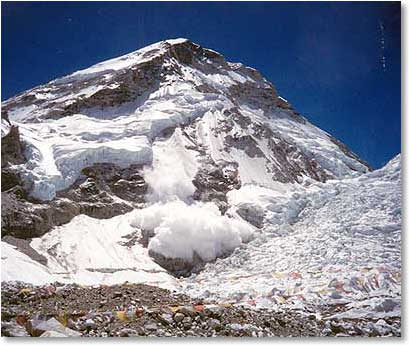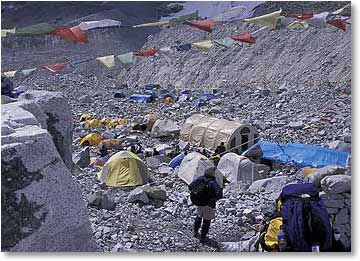|
October 12th - Calling from Everest Base Camp
This is Wally Berg calling in from Everest Base Camp. The entire Berg Adventures team is here now.
First of all I would like to welcome the viewers of KCCI TV in Des Moines, Iowa, on behalf of www.bergadventures.com and www.everestnews.com who may have listened to an interview with the hometown boy Steve Lombardi checking in with us to follow our progress.
I should back up just a bit; I reported yesterday afternoon about the changes of the weather and I was only partly right about that. It was snowing and cloudy by afternoon again, even though we had an exceptional clear morning. All the same Dafna, Mark, Mingma Sherpa and Khung Karma started up for Kala Pathar in the bad weather. They actually climbed quite quickly up to the highest of the 4 viewpoints on Kala Pathar - which is about 18,300 feet - and just as they arrived at the top, the clouds parted and they were treated to a beautiful view of the summits of Everest and Lhotse. They felt great by the time they walked back down and joined us at camp.
 Today we got up and walked up the Khumbu glacier moraine into Base Camp. We arrived at a very quiet, beautiful and an inspiring scene. There is always rumbling and roaring from avalanches crushing around on the big mountain walls and of course we looked up into the Khumbu Icefall. Today we got up and walked up the Khumbu glacier moraine into Base Camp. We arrived at a very quiet, beautiful and an inspiring scene. There is always rumbling and roaring from avalanches crushing around on the big mountain walls and of course we looked up into the Khumbu Icefall.
Base camp is very quiet now; we knew it was over for the season when we saw the aluminium ladders being carried back down to Gorak Shep, where they will be stored until next season, these ladders having come out of the ice fall.
When you arrive at Base Camp, one of the first things that you always realize is that it is not a place, in the sense that many people imagine, especially when you see it being disassembled or you come in after the teams have left.
By that I mean it sits on a glacier moraine. It is active, cracking and moving all the time. I always walk in here and identify certain large rocks that I remembered from previous years; but essentially, I am on a different place every year. Tent platforms have to be reconstructed. The Korean, Brazilian and Japanese teams who resided here for weeks this year know well as the moraine cracks underneath their tents - even in this short period of time. This will be a different place when the teams return next spring.
 When we arrived at base camp, we saw the teams packing up; the Japanese are still around, I haven’t talked to them about their exact plans. We saw a lot of workers out, combing the area all around, not just the base camp proper, but the entire area, with blue SPCC bags. When we arrived at base camp, we saw the teams packing up; the Japanese are still around, I haven’t talked to them about their exact plans. We saw a lot of workers out, combing the area all around, not just the base camp proper, but the entire area, with blue SPCC bags.
This brings up an interesting point that I talk about almost always when I come to base camp. one of the myths about Everest base camp is that “There are mountains of trash lying around”.
I haven’t seen significant quantity of trash when I come into an unoccupied Everest base camp since about 1993. A lot of people deserve credit for this, but the Nepalese government and Nepalese organizations rarely receive the credit they deserve.
The SPCC is the Sagarmatha Pollution Control Commission. Each team that climbs on Everest leaves a US$4000,00 dollars deposit for the Nepalese government refundable when they remove their trash. They also leave a separate US$2000.00 deposit for when they pull the numbers of oxygen bottles off the mountain that they have imported into Nepal. This is not a part of any environmental expedition; Environmental Expeditions have to pay the same deposits and receive the same refund when they remove their trash. One of the easiest things in the world to do is to come to Everest Base camp and take pictures of mountains of trash during the expeditions before it has been removed.
A few minutes later a good friend of mine Pasang Sherpa showed up in base camp, Pasang is the Sirdar of the French team on Pumori. He was looking for the SPCC officer so that he could report in and get someone from SPCC to come and inspect his camp site clearing him that they are not leaving any rubbish behind. So the system is working well.
I report mainly not to detract from the good efforts of the Environmental Clean up teams in recent years, especially for the efforts to clean up Camp 2.
Finally before I leave Base Camp today I feel like I should talk about the Swiss team. The Swiss made strong attempts on the route in the spring and autumn of 1952; I remembered the British team was quick to acknowledge that the work they did on the route; the scientific information they gathered about the different elevations, the use of oxygen and everything else was essential to the success of Hillary and Tenzing in the spring of 1953. Interesting enough Tenzing Norgay was on both of those Swiss attempts in 1952.
You can read about these adventures of the Swiss in 1952 and Tenzing’s entire climbing career as well as a lot of great Sherpa climbers in the excellent new book by my friend, Tashi Tenzing, the grandson of Tensing Norgay. It is called Tenzing and the Sherpa of Everest, published by HarperCollins - the best book by far I have read on the history of Sherpa climbers and Mount Everest.
|